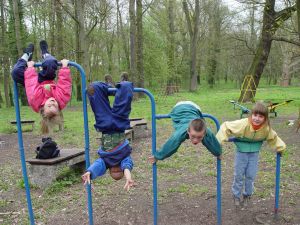By Rita Brhel, managing editor of Attached Family magazine, API’s Publications Coordinator and an API Leader (Hastings API, Nebraska, USA)
 Television, computers and other technology can offer a lot in terms of education and entertainment. Living in a temperate region with bitter winters and sweltering summers, there are seasons when my outdoors-loving family prefers time inside, and I have found creative ways to turn screen time into interactive family time as needed.
Television, computers and other technology can offer a lot in terms of education and entertainment. Living in a temperate region with bitter winters and sweltering summers, there are seasons when my outdoors-loving family prefers time inside, and I have found creative ways to turn screen time into interactive family time as needed.
However, I also have to admit that it can be tempting, especially in the seemingly endless winter months, to overdo the screen time. Screen-Free Week—being observed this year from May 5-11—serves as an annual reminder to balance screen time with time away from technology.
Attachment Parenting International (API) promotes a balance of screen time within the family as one of the many ways to prioritize the parent-child relationship. Each year, API’s online magazine, blog, social media sites and other online resources go quiet in support of Screen-Free Week. We’re excited to be able to bring you this interview with Sara Adelmann, MA, with the Campaign for a Commercial-Free Childhood, home of Screen-Free Week, to further inspire your family to take part in this international event.
RITA: Thank you, Sara, for your time. I understand that this is a very busy time of the year for you as Campaign for a Commercial-Free Childhood (CCFC) gets ready for Screen-Free Week. API embraces Screen-Free Week as an opportunity to educate and support parents in reducing screen time in their homes. Let’s start by learning more about CCFC and Screen-Free Week.
SARA: CCFC is the proud home to Screen-Free Week. We set the dates each year, provide resources and help spread the word. But it’s the thousands of individuals all over the world who organize local events. Anyone can organize Screen-Free Week in a classroom or entire school, with a scout troop, faith community, neighborhood association, at a local library or in any community group. Organizers and volunteers promote the week, reach out to partners, and help children and families discover fun, screen-free activities.
Screen-Free Week celebrations vary from family to family, school to school and town to town. Every year, we hear from organizers and participants around the globe about all of the fun screen-free activities they’ve discovered. Visit www.screenfree.org to find out how you can get involved—for the children in your life, for yourself and for a more positive, healthier future.
RITA: Screen-Free Week is an innovative project and so needed in our tech-heavy culture. What originally inspired CCFC to organize Screen-Free Week?
SARA: Reducing children’s screen time and advocating for screen-free, commercial-free time and space has always been essential to CCFC’s mission. That’s why when the Center for Screen-Time Awareness closed its doors [in 2010] and asked us to become the new official home of what used to be called “TV-Turnoff” [since 1994], we leaped at the chance.
Children are spending way too much time with screens—a staggering 32 hours per week for preschoolers and even more for older kids. And now, with mobile devices, children are immersed in screens, and the things they sell, nearly every waking moment. Regardless of content, excessive screen time changes children’s fundamental connection to the world. It deprives them of hands-on creative play—the foundation of learning, creativity, constructive problem solving and the capacity to wrestle with life to make it meaningful. And the costs are extraordinary: poor school performance, childhood obesity and problems with attention are just a few.
Turning off screens for seven days helps participants realize that life without screens is not impossible and is actually fun. A week-long turnoff allows sufficient time to explore a wide range of screen-free activities and develop more productive and healthy habits. Giving children the chance to play actively, develop relationships and learn to evaluate options will help them become more well-rounded people, better educated citizens and more alert consumers.
RITA: API loves how Screen-Free Week promotes families spending time together beyond technology, but we recognize that in many families, at least some screen time is the norm. How much screen time is too much?
SARA: Research links excessive screen time with many of the health and social problems facing children today, including learning, attention and social problems, childhood obesity and sleep disturbances. In addition, the more time our youngest children spend with screens, the less time they spend interacting with caring adults and in hands-on, creative play—two activities proven to be important for learning. It also exposes kids to lots of harmful advertising and can be habit forming.
It’s vital that parents monitor the amount of time their children spend with screen media. With so many different devices available these days, parents might not realize how much time their children are spending with screens—minutes can easily turn into hours. Setting rules early on about when, where, what and how much is important.

 Dahlia was running around the house screaming and crying. “I hate her! I hate her! I will never play with her again!”
Dahlia was running around the house screaming and crying. “I hate her! I hate her! I will never play with her again!”